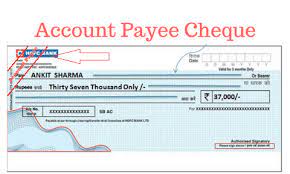Cheques are a common method of payment in India since they are both safe and straightforward. Many cheques, such as crossing cheques, holder paycheques, and ac payee cheques, confuse people. For a better understanding, let us go through Account Payee Cheque in depth.
What is an Account Payee Cheque?
An Account Payee Cheque is a heavily secured form of cheque since the money can only be put into the payee’s account. The payee is not permitted to sign this check for anybody else. To fully grasp the notion, one must first comprehend the distinction between a drawer, drawee, and payee.
- Drawer: A drawer is a person who signs the check and places his signature on it. They are usually the people whose accounts the receiver withdraws money from to demonstrate their authorization.
- Drawee: The person or organization to whom a cheque is made payable is known as the drawee. Banks are often the drawees, receiving orders from drawers to withdraw cash.
- Payee: A payee is a company or individual to whom you make payment. The cheques bear their signature.
As a result, the bank only transfers cash into the payee’s accounts to make the payment in an account payee cheque.
How to write an A/C Payee cheque?

- Draw two diagonal lines on the left edge of the cheque and cross them to make an account payee cheque. Furthermore, you must write “Account Payee” across the two lines indicated.
- It is important to note that if you simply draw lines on the check without writing “Account Payee,” the bank will see it as a canceled cheque rather than an account payee cheque.
- Fill in the date, amount, recipient’s name, and signature.
In terms of features, a crossed cheque varies from an account payee cheque. As a result, distinguishing between the two is critical.
How is A/C Payee Cheque different from other cheques?
In regards to endorsement, an account payee check differs significantly from a bearer cheque and from crossed and order cheques. Furthermore, an account payee check is a very secure instrument, but a bearer cheque is the most vulnerable to misappropriation.
- Crossed Cheque: A crossed cheque is one whose proceeds can only be deposited into the account of the payee. However, such cheques can be endorsed to a third party by the payee, who can then endorse it to someone else. Such an endorsement can be done by putting the name of the endorsee on the cheque and signing on the reverse of the cheque leaf.
- Bearer Cheque: Every cheque is a bearer cheque until the term bearer or any other sort of crossing is crossed on it. The individual holding the check can cash it over the counter. This sort of check is extremely insecure and can be exploited if lost. Furthermore, these checks do not need to be endorsed and may be quickly given on to a third party.
- Order Cheque: An order cheque is one that has the term ‘Bearer’ crossed out and the words ‘to Order’ put on it. This form of the cheque has comparable properties to a bearer cheque, however, it cannot be endorsed simply by giving it over to another individual. To be legitimate, it must be properly signed and endorsed.
Importance of A/C Payee cheque
The fundamental reason for the popularity of writing account payee checks is that they are the safest sort of check. The funds will be transferred immediately into the recipient’s account. The fact that the payee is unable to endorse the check to another party only adds to its security. Account payee checks are valid for three months.
How to deposit or encash the A/C Payee cheque?
- If you get an account payee cheque, keep in mind that you cannot cash it at the counter. You must deposit it into your bank account using the check deposit slip.
- First, fill out the cheque deposit slip with all of your information.
- Attach it to the cheque and hand it to the customer service person or put it in the cheque drop box.
- After a few days, the amount of the cheque will be deposited immediately into your account. That is how an A/C Payee Cheque is encashed.
- Remember to write the bank account number and cellphone number on the reverse of the cheque leaf. It guaranteed that your funds were credited to the correct account even if the deposit slip became detached.
Leave a Reply